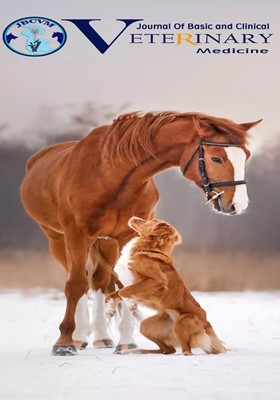Biochemical parameters changes in infected dogs with Babesia canis in Urmia, Iran
Subject Areas : Clinical Pathology
kaveh Azimzadeh
1
*
![]() ,
parisa Mohammadisefat
2
,
parisa Mohammadisefat
2
![]()
1 - Young Researchers and Elite Club, Urmia Branch, Islamic Azad University, Urmia, Iran
2 - University of Agricultural Sciences and Natural Sources, Sari, Iran
Keywords: Malondialdehyde, Urmia, Aspartate aminotransferase, Alanine aminotransferase, Canine babesiosis,
Abstract :
The aim of this study was to evaluate the changes in the biochemical parameters in infected dogs with babesiosis in 3 levels. The Babesia genus, as pathogen blood parasites, cause financial problems in livestock industry. Many published papers have suggested babesiosis-induced biochemical parameters, but no study has determined these parameters at four levels of parasitemia (less than 1%, 1%, 2% and 3%). Dogs with babesiosis were identified based on clinical signs and the observation in red blood cells. After blood sampling from 38 infected and 38 healthy dogs, biochemical parameters glucose paraoxonase, superoxide dismutase, catalase, glutathione peroxidase and adenosinedeaminas were measured in plasma. The results indicated significant increase and decrease in biochemical parameters. In conclusion, the results suggested that dog babesiosis causes cellular damage, especially in kidney and anemia in infected dogs. Furthermore, babesiosis caused kidney damage. This infection affected the activity of liver enzymes. The obtained results revealed a highly significant increase in serum Aspartate aminotransferase and Alanine aminotransferase.
[1] Motevalli Haghi SM, Fakhar M, Sharif M, Keyghobadi M. An overview on different diagnostic methods for babesiosis. Journal of Mazandaran University of Medical Sciences. 2014 15;23(109):283-95.
[2] Martínez-García G, Santamaría-Espinosa RM, Lira-Amaya JJ, Figueroa JV. Challenges in Tick-Borne Pathogen Detection: The Case for Babesia spp. Identification in the Tick Vector. Pathogens. 2021;10(2): 92.
[3] Parashar R, Sudan V, Jaiswal AK, Srivastava A, Shanker D. Evaluation of clinical, biochemical and haematological markers in natural infection of canine monocytic ehrlichiosis. Journal of Parasitic Diseases. 2016;40(4):1351-4.
[4] Gaweł S, Wardas M, Niedworok E, Wardas P. Malondialdehyde (MDA) as a lipid peroxidation marker. Wiadomosci lekarskie (Warsaw, Poland: 1960). 2004 .1;57(9-10):453-5.
[5] Mohamed SM. Studies of Naturally Infected Babesiosis and Its Effect on Some Hematological and Biochemical Parameters in Cattle in Qena. Egypt. J. Vet. Sci. 2017;1(2):1-9.
[6] Pigeolet E, Corbisier P, Houbion A, Lambert D, Michiels C, Raes M, Zachary MD, Remacle J. Glutathione peroxidase, superoxide dismutase, and catalase inactivation by peroxides and oxygen derived free radicals. Mechanisms of ageing and development. 1999 15;51(3):283-97.
[7] Sherman, Kenneth E. Alanine Aminotransferase in Clinical Practice. A Review. Archives of Internal Medicine 1991. 151(2): 260–65.
[8] Mittal M, Kundu K, Chakravarti S, Mohapatra JK, Singh VK, Kumar BR, Thakur V, Churamani CP, Kumar A. Canine babesiosis among working dogs of organised kennels in India: A comprehensive haematological, biochemical, clinicopathological and molecular epidemiological multiregional study. Preventive veterinary medicine. 2019 1;169:104696.
[9] Panteghini M. Aspartate aminotransferase isoenzymes. Clinical biochemistry. 1990 1;23(4):311-9.
[10] Sevinc F, Turgut K, Sevinc M, Ekici OD, Coskun A, Koc Y, Erol M, Ica A. Therapeutic and prophylactic efficacy of imidocarb dipropionate on experimental Babesia ovis infection of lambs. Veterinary parasitology. 2007 21;149(1-2):65-71.
[11] Chaudhuri S, Varshney JP, Patra RC. Erythrocytic antioxidant defense, lipid peroxides level and blood iron, zinc and copper concentrations in dogs naturally infected with Babesia gibsoni. Research in Veterinary Science. 2008 1;85(1):120-4.
[12] Crnogaj M, Petlevski R, Mrljak V, Kis I, Torti M, Kucer N, Matijatko V, Sacer I, Stokovic I. Malondialdehyde levels in serum of dogs infected with Babesia canis. Veterinární medicína. 2010 19;55(4):163-71.
[13] Rezaei SA, Dalir-Naghadeh B. Evaluation of antioxidant status and oxidative stress in cattle naturally infected with Theileria annulata. Veterinary parasitology. 2006 30;142(1-2):179-86.
[14] Aysul N, Ural K, Ulutas B, Eren H, Karagenc T. First detection and molecular identification of Babesia gibsoni in two dogs from the Aydın Province of Turkey. Turkish Journal of Veterinary and Animal Sciences. 2013 2;37(2):226-9.

